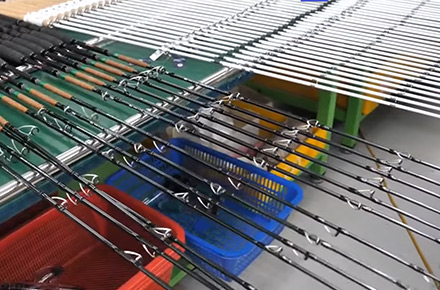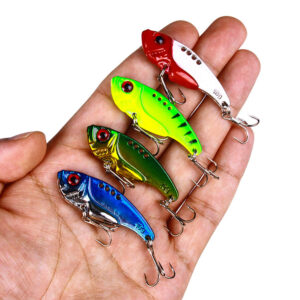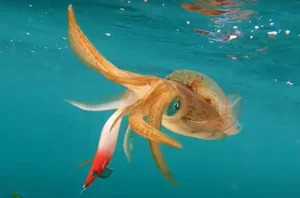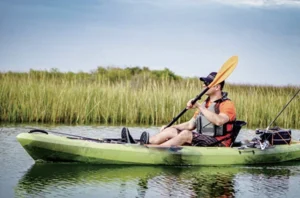If you’re an avid fisherman, you know how important it is to take care of your fishing equipment. One of the most crucial pieces of gear is your fishing rod. Proper maintenance and care of your fishing rod will extend its lifespan. It will also ensure optimal performance on your fishing trips. This guide covers all you need to know about keeping up your fishing rod. It covers cleaning, storage, and fixing and replacing parts. So let’s dive in and learn how to keep your fishing rod in top shape!
Table of Contents
1. Introduction
Your fishing rod is your most valuable tool when it comes to catching fish. It’s essential to take care of it so that it performs at its best. Proper maintenance involves regular cleaning, inspection, and repair. Additionally, knowing how to store and transport your rod can prevent damage. In this guide, we’ll cover these aspects in detail. We’ll ensure that you have the knowledge and skills to keep your fishing rod working well.
2. Cleaning Your Fishing Rod
You must clean your fishing rod. This is key to removing dirt, debris, and salt buildup. Cleaning keeps your rod looking great. It also stops rust and damage. Let’s explore the step-by-step process of cleaning your fishing rod.
Cleaning the Rod Blank
- Start by removing the reel and any attached accessories, such as lines or lures.
- Fill a bucket or sink with warm water and add a mild detergent or fishing rod cleaner.
- Dip a soft cloth or sponge into the soapy water and gently wipe down the rod blank from the handle to the tip.
- Pay extra attention to areas with visible dirt or grime, such as the handle and reel seat.
- Rinse the rod blank thoroughly with clean water to remove any soap residue.
- Wipe the rod dry with a clean towel or allow it to air dry completely before reassembling.
Cleaning the Guides and Reel Seat
- Use a soft brush, such as a toothbrush, to gently scrub the guides and reel seat.
- Pay close attention to the guide inserts to remove any salt or dirt buildup.
- Rinse the guides and reel the seat with clean water to remove any debris.
- Dry the guides and reel seat with a soft cloth or allow them to air dry completely.
- Inspect the guides for any signs of damage or corrosion (we’ll cover this in more detail in the next section).
3. Inspecting Your Fishing Rod
Regular inspections are crucial to identify any issues with your fishing rod. By catching problems early, you can prevent further damage and make timely repairs. Let’s go through the step-by-step process of inspecting your fishing rod.
Checking the Rod Blank
- Start by looking at the whole rod blank. Look for any damage, like cracks or splintering.
- Run your fingers along the rod blank, feeling for any rough spots or abnormalities.
- Pay close attention to the guides’ alignment and spacing along the rod blank.
- Look for any loose or damaged guide wraps, which can affect the rod’s performance.
- If you notice any big damage, consult a pro rod builder or repair tech.
Inspecting the Guides and Tip Top
- Examine each guide closely for any signs of damage, such as bent frames or cracked inserts.
- Check the guide inserts for wear or corrosion. These can cause line wear and reduce casting distance.
- Look for any loose or missing guide wraps and make a note of them for repair or replacement.
- Inspect the tip-top guide for alignment and any signs of damage or wear.
Thoroughly inspect your fishing rod. You can find and fix any issues before they worsen. You should inspect your rod regularly. It’s part of maintenance. It keeps the rod in good condition.
4. Repairing Your Fishing Rod
Sometimes, despite your best efforts, your fishing rod may require repairs. In this section, we’ll cover some common repairs you can do. For example, fixing guide wraps. Also, replacing broken guides and fixing a broken rod blank.
Fixing Guide Wraps
- If you notice a loose or damaged guide wrap, carefully remove the old thread using a razor blade or small knife.
- Clean the guide foot and the area around it with rubbing alcohol. This removes any leftover adhesive.
- Apply a small amount of road-building epoxy to the guide foot and carefully position it back in place.
- Use a thread-wrapping tool or your fingers to wrap the thread around the guide foot, securing it in place.
- Apply additional epoxy to the thread wraps to ensure a secure bond.
- Let the epoxy fully cure. Follow the manufacturer’s instructions. Only then use the rod.
Replacing Broken Guides
- If a guide is significantly damaged or broken, it’s best to replace it entirely.
- Start by carefully removing the damaged guide. Use a guide removal tool or cut the guide foot and remove it in sections.
- Clean the guide foot area with rubbing alcohol to remove any adhesive residue.
- Select a replacement guide of the same size and style as the original.
- Apply rod-building epoxy to the guide foot and position the new guide in place.
- Use a thread-wrapping tool or your fingers to wrap the thread around the guide foot, securing it in place.
- Apply more epoxy to the thread wraps to ensure a secure bond.
- Allow the epoxy to cure before using the rod.
Repairing a Broken Rod Blank
- If your rod blank is broken, it’s best to ask a pro rod builder or repair tech for help.
- They will have the expertise and tools necessary to repair or replace a broken rod blank.
- If you try to fix a broken rod yourself, you might cause more damage. You might also weaken the rod.
5. Replacing Components
Sometimes, you may want to upgrade or change parts of your fishing rod. In this section, we’ll explore how to replace guides, reel seats, and grips. This will improve your rod’s performance or change its look.
Upgrading the Guides
- Upgrading your rod’s guides can improve casting distance and reduce line wear.
- Start by picking guides of the right size and style. Choose them for your rod and the way you’ll fish.
- Remove the old guides. Follow the steps in the “Replacing Broken Guides” section.
- Clean the guide foot area with rubbing alcohol to remove any adhesive residue.
- Apply rod-building epoxy to the guide foot and carefully position the new guides in place.
- Use a thread-wrapping tool or your fingers to wrap the thread around the guide foot, securing it in place.
- Apply additional epoxy to the thread wraps to ensure a secure bond.
- Allow the epoxy to fully cure before using the rod.
Swapping Reel Seats
- If you want to upgrade or change the reel seat on your fishing rod, start by removing the old reel seat.
- Carefully cut or sand away the adhesive and thread wrap holding the old reel seat in place.
- Clean the rod blank thoroughly to remove any residue.
- Select a new reel seat that matches the style and size of your fishing reel.
- Apply rod-building epoxy to the reel seat and carefully position it on the rod blank.
- Use a thread-wrapping tool or your fingers to wrap the thread around the reel seat, securing it in place.
- Apply additional epoxy to the thread wraps to ensure a secure bond.
- Allow the epoxy to fully cure before using the rod.
Changing the Grip
- If you want to customize the grip on your fishing rod, start by removing the old grip.
- Carefully cut or sand away the adhesive and thread wrap holding the old grip in place.
- Clean the rod blank thoroughly to remove any residue.
- Select a new grip material and style that suits your preferences.
- Apply rod-building epoxy to the rod blank and carefully position the new grip in place.
- Use a thread-wrapping tool or your fingers to wrap the thread around the grip, securing it in place.
- Apply additional epoxy to the thread wraps to ensure a secure bond.
- Allow the epoxy to fully cure before using the rod.
By swapping out parts on your fishing rod, you can improve its performance. You can also customize its look and make it truly your own.
6. Storing Your Fishing Rod
Proper storage is crucial to prevent damage and prolong the lifespan of your fishing rod. In this section, we’ll explore the best practices for storing your fishing rod to keep it in top shape.
Choosing the Right Rod Storage
- Consider investing in a rod rack or holder specifically designed for fishing rods.
- A rod rack allows you to store your rods vertically, keeping them safe from damage.
- If a rod rack is not an option, store your rods horizontally in a rod tube or case.
Properly Coiling the Line
- Before storing your fishing rod, ensure that the fishing line is properly coiled.
- Remove any lures or hooks from the line and wind them evenly onto the reel.
- Don’t overfill the reel spool. It can tangle the line and hurt casting.
- Use a line winder or your hand to guide the line onto the reel evenly.
Choosing the right storage method is important. Coiling the fishing line properly will keep your fishing rod in good condition. It will stay in good condition between trips.
7. Transporting Your Fishing Rod
Transporting your fishing rod safely is essential to prevent damage while on the go. In this section, we’ll explore some tips for transporting your fishing rod securely.
Using Rod Tubes or Cases
- Invest in a quality fishing rod tube or case to protect your rod during transportation.
- Rod tubes or cases provide a secure and padded environment for your fishing rod.
- Choose a tube or case that fits your rod’s length and provides ample protection.
Protecting the Rod in a Vehicle
- When transporting your fishing rod in a vehicle, place it in a secure location, such as the trunk or a rod rack.
- Avoid placing heavy objects on top of the rod or applying excessive pressure.
- Use soft rod socks or sleeves. They prevent scratches or damage during transport.
Follow these tips. They will help you transport your fishing rod safely. They will ensure it arrives undamaged at your fishing spot.
8. Preventing Common Rod Issues
Prevention is key when it comes to maintaining your fishing rod. Avoid common issues. Doing so can lengthen your rod’s life and prevent costly repairs. In this section, we’ll explore some tips for preventing common rod issues.
Avoiding High-Impact Situations
- Be mindful of your fishing rod’s surroundings. Avoid situations that could lead to high impacts, like dropping or stepping on the rod.
- Handle your rod with care when casting, landing fish, or transporting it.
Keeping the Rod Away from Extreme Temperatures
- Extreme temperatures can harm your fishing rod. So, avoid leaving it in direct sunlight or extreme heat for a long time.
- Similarly, avoid exposing your rod to extreme cold. It can make the materials brittle and prone to breakage.
Be mindful of your rod’s surroundings. Avoid extreme temps. You can prevent common rod issues and ensure its life.
9. Frequently Asked Questions
How often should I clean my fishing rod?
How often you clean your fishing rod depends on how often you use it and the conditions where you fish. As a general rule, it’s a good idea to clean your rod after each fishing trip or at least once every few weeks.
Can I use soap and water to clean my rod?
Soap and water are safe for cleaning your fishing rod. But, use a mild detergent or rod cleaner made for this purpose. Avoid using harsh chemicals that could damage the rod’s components.
How can I prevent my rod guides from corroding?
To prevent guide corrosion, rinse your rod with fresh water. Do this after each saltwater fishing trip. Additionally, apply a thin layer of reel oil or silicone lubricant to the guide frames. This provides extra protection against corrosion.
10. Conclusion
You must maintain your fishing rod. This is key to keep it working well and make it last longer. Follow the cleaning, inspection, and repair techniques in this guide. They will keep your rod in top shape for years. Remember to store and move your rod safely. Also, take steps to avoid common rod issues. With care and maintenance, your fishing rod will last. It will give you enjoyable and successful fishing trips. Happy fishing!






